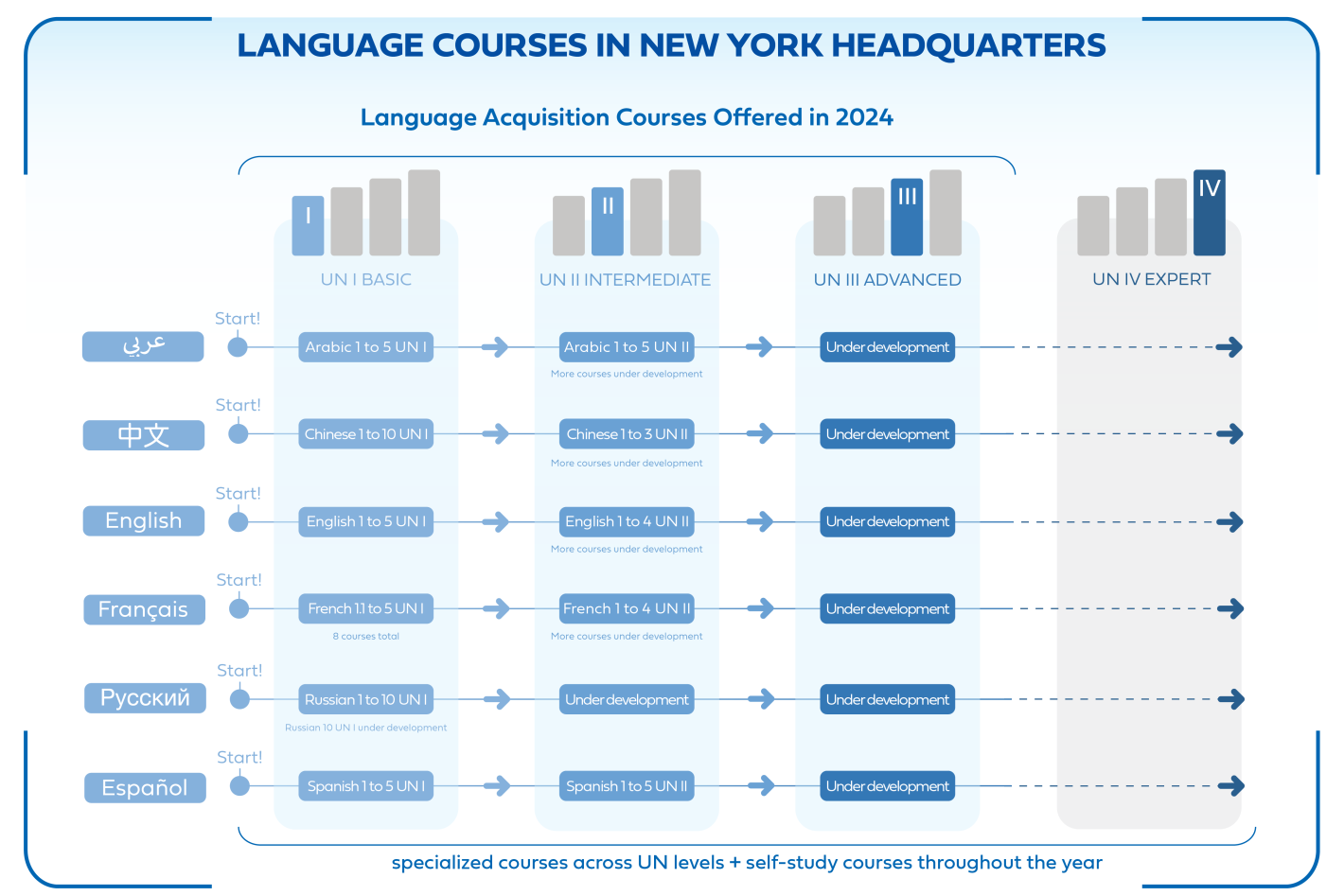Six Official Languages in a nutshell
Arabic is an official and working language
- of the General Assembly since 1973
- of the subsidiary organs of the General Assembly since 1980
- of the Security Council since 1982
Arabic is an official language
- of the Economic and Social Council
Arabic is also considered a working language
- of the Economic Commission for Africa
- of the Economic and Social Commission for Western Asia
Source: Multilingualism at the UN. Why it matters
The Arabic language used and assessed in the United Nations is the Modern Standard Arabic or fuS-Ha, both in written and spoken standards.
However, special attention will be paid to one or more main spoken dialects, as these are essential for everyday communication. Decisions on which dialect(s) will be prioritised in language learning, especially for oral components, will be taken locally and to fulfil the most immediate communication needs.
Chinese is an official language of the United Nations since 1946
Chinese is a working language
- of the General Assembly since 1973
- of the Security Council since 1974
Chinese is also considered a working language
- of the Economic and Social Commission for Asia and the Pacific
Source: Multilingualism at the UN. Why it matters
The Chinese language features a morpho-syllabic writing system that encodes meaning into each writing unit, the character. The language is also known for its highly productive creation of compound words, formed by piecing together characters.
Despite its unique writing system and tones, Chinese has a relatively uncomplicated grammar without verb conjugation (e.g., marking tenses in verbs) and noun declension (e.g., marking genders or numbers in nouns). Furthermore, technology is making it easier to learn the writing and romanization system using a familiar keyboard.
English is an official and working language of the United Nations since 1946
English is also the official language of the International Court of Justice.
English is also considered a working language
- of the Economic and Social Commission for Africa
- of the Economic Commission for Europe
- of the Economic Commission for Latin America and The Caribbean
- of the Economic and Social Commission for Asia and the Pacific
of the Economic and Social Commission for Western Asia
Source: Multilingualism at the UN. Why it matters
The written standard at the United Nations is British English. Most personnel will have English language competence at the time of their appointment. Throughout their career, staff will be able to enhance their written and oral skills to communicate effectively in UN-specific contexts and in accordance with text types and conventions.
French is an official and working language of the United Nations since 1946
French is also the official language of the International Court of Justice.
French is also considered a working language
- of the Economic and Social Commission for Africa
- of the Economic Commission for Europe
- of the Economic Commission for Latin America and The Caribbean
- of the Economic and Social Commission for Asia and the Pacific
- of the Economic and Social Commission for Western Asia
Source: Multilingualism at the UN. Why it matters
French is an official language in 29 countries across multiple continents, most of which are members of the Organisation internationale de la Francophonie (OIF). While there are phonological, lexical, syntactical features, and diverse accents in each area, the language is understandable by all Francophones.
Russian is an official language of the United Nations since 1946
Russian is a working language
- of the General Assembly since 1968
- of the Security Council since 1969
Russian is also considered a working language
- of the Economic Commission for Europe
- of the Economic and Social Commission for Asia and the Pacific
Source: Multilingualism at the UN. Why it matters
The Russian alphabet can be learnt in just one day, enabling the recognition of simple words and even sentences. The Russian language has a developed grammatical case system, which gives a fascinating insight into how language produces meaning.
Russian-speaking people of many ethnicities have contributed to the richest artistic and cultural traditions in the world, recognized for its achievements in music, theatre, ballet, visual arts, literature, and film.
Spanish is an official language of the United Nations since 1946
Spanish is a working language
- of the General Assembly since 1948
- of the Security Council since 1969
Spanish is considered a working language
- of the Economic Commission for Latin America and The Caribbean
Source: Multilingualism at the UN. Why it matters
The Spanish language is widely distributed across different geographical areas, mainly on the American continent. While there are obvious phonological, lexical, and syntactical features for each main linguistic area, the Spanish language remains consistent and completely understandable throughout its geography.
All varieties of the language are considered equally suitable for learning and assessing purposes.

